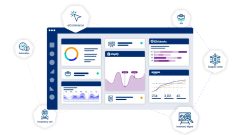Building a Smarter End-to-End Manufacturing Ecosystem with Connected Software

The efficiency and agility of a manufacturing operation are significantly enhanced when key processes work in harmony. Sadly, many manufacturers today still rely on disparate systems, where critical functions like material sourcing, production, and inventory management operate in isolation and don’t communicate well. This fragmented approach often leads to inefficiencies, data silos, and a lack of clear visibility across the entire production lifecycle.
End-to-end manufacturing software offers a powerful solution by unifying the entire manufacturing life cycle within a single, integrated platform. This cohesive approach streamlines workflows, enables real-time visibility, facilitates faster and better decision-making, and improves coordination across departments.
In this post, we’ll dive into what end-to-end manufacturing really means, how it benefits manufacturers, and key factors to consider when selecting a software vendor. We’ll also look at some best practices for a smooth and successful implementation of end-to-end manufacturing software.
What is End-to-End in Manufacturing?
End‑to‑end manufacturing is a holistic approach to manufacturing that connects every phase of the manufacturing process — from the initial conception of a product, to raw-material sourcing and production planning, to execution, quality control, and delivery.
This interconnectedness is typically facilitated by a unified software system that acts as the operation’s central nervous system, offering complete visibility and control across the entire production journey.
Key Benefits of a Unified Manufacturing Workflow
Here are the benefits that manufacturers can expect from a unified manufacturing workflow.
Faster Response to Change
A unified workflow makes it easier to adapt to changes in customer needs, market conditions, or supply chain disruptions. Since all departments operate from the same real-time data and interconnected processes, teams can react quickly without waiting for manual updates or cross-functional approvals. Whether it’s rerouting a production run or switching suppliers, decisions can be made and executed faster with minimal disruption to overall operations.
Enhanced Operational Efficiency
When all departments are connected through a single platform, information flows freely and in real-time. This eliminates the delays, errors, and duplicated efforts that often plague manufacturers using fragmented systems. The ultimate result is improved efficiency and output.
Greater Visibility and Control
One of the most powerful advantages of a unified manufacturing workflow is real-time visibility into operations across the entire production lifecycle. Managers and executives can monitor everything from shop floor activity and equipment performance to inventory turnover and supplier lead times, all within a centralized dashboard.
This level of transparency makes it easier to track progress, spot emerging issues before they escalate, and make informed adjustments on the fly. Instead of reacting to problems after the fact, teams gain proactive control.
Reduced Costs and Waste
Fragmented workflows often lead to inefficiencies that drive up costs and create waste, whether through excess inventory, overproduction, or unnecessary energy usage. A unified workflow improves coordination across departments, helping to align production planning, inventory management, and procurement strategies. This can result in lower costs and waste. For example, more efficient inventory management and capacity requirement planning helps prevent overstocking, whose consequences include higher carrying costs and the risk of obsolescence.
Enhanced Collaboration and Communication
A unified platform fosters better communication and collaboration across different teams. Everyone operates with the same information, leading to improved coordination, reduced misunderstandings, and a more cohesive working environment. This seamless collaboration is vital for tackling complex challenges and driving innovation.
Stronger Customer Satisfaction
Ultimately, a unified workflow enables manufacturers to deliver a better end product and customer experience. With synchronized operations and greater control, companies are better positioned to meet delivery deadlines, maintain consistent product quality, and respond promptly to customer inquiries or changes.
Additionally, having full visibility into the customer journey empowers service teams to provide accurate updates and proactive communication. These capabilities contribute to higher customer trust, satisfaction, and retention, creating long-term value and repeat business.
Reduced Total Cost of Ownership (TCO)
Operating multiple point solutions often leads to higher costs in terms of software licensing, maintenance, and training. By consolidating systems into one unified platform, manufacturers can lower their IT overhead and reduce the complexity of managing several different technologies.
Additionally, a single system simplifies updates and support, as there’s only one platform to maintain and optimize. Over time, this consolidation results in cost savings and a lower total cost of ownership (TCO), allowing manufacturers to allocate resources more effectively and focus on growth.
Transparency and Traceability
A unified system captures every detail of the product life cycle, from raw material intake to final shipment. Every change, inspection, approval, and process step is logged and easily accessible, creating a reliable digital audit trail. This level of transparency not only simplifies compliance and accelerates regulatory audits but also enhances quality assurance. When issues arise, teams can quickly trace them back to their source, implement corrective actions, and prevent recurrence.
Speed-to-Market
Getting products to customers quickly can be a major competitive advantage. A unified manufacturing workflow compresses time-to-market by eliminating the delays and communication gaps that often occur between departments. Design teams can seamlessly pass specifications to production, procurement can align materials in advance, and engineering changes can be implemented without manual coordination.
How to Choose the Right End-to-End Manufacturing Software
The right end-to-end manufacturing software is the one that aligns with your business model, supports your strategic goals, and scales with your growth trajectory. With numerous options on the market, choosing the right system can feel overwhelming. But by focusing on a few key areas, you can make a confident, informed decision that will benefit your operations both now and in the future.
Evaluate Flexibility and Scalability
Flexibility and scalability are essential traits to look for in any end-to-end manufacturing solution, especially if you're planning for long-term growth. Flexibility refers to the system’s ability to adapt to your specific workflows, production models, and operational nuances. This is especially important if your manufacturing operations vary across different product lines or involve both standardized and customized production. A flexible solution can adjust to changes in product design, customer demands, or production methods without requiring a complete overhaul of the system.
Scalability, on the other hand, is about the software's capacity to grow with your business. As your operations expand, the system should be able to handle increased production volumes, additional locations, or more complex workflows.
Consider Industry-Specific Capabilities
When evaluating end-to-end manufacturing software, it’s essential to consider how well the solution aligns with the specific needs and complexities of your industry. Every manufacturing sector has unique requirements, regulations, and operational challenges. Software tailored to these industry specifics can provide a significant advantage by offering specialized features, compliance tools, and workflows that are specifically designed to optimize the processes you deal with daily.
For example, the automotive industry might require advanced quality control features to track component performance and traceability at every step of production, while the pharmaceutical sector might need robust compliance and regulatory tracking to meet the stringent standards of this industry.
Choosing software that offers these industry-specific capabilities can streamline operations, minimize the risk of compliance issues, and reduce the need for extensive customizations.
Consider User Experience
Even the most powerful software won’t deliver results if your team struggles to use it. A solution with a clean, intuitive interface ensures faster onboarding and greater user adoption across departments.
Additionally, evaluate the level of support and training that comes with the software. A vendor that offers strong customer support, training resources, and implementation assistance will make the transition smoother and ensure ongoing success.
Assess Vendor Reputation and Reviews
Don’t choose a software solution based solely on its features; consider the reputation of the vendor too. Read customer reviews, case studies, and third-party assessments to get a sense of the vendor’s track record with similar organizations. A trusted vendor should not only provide a reliable product but also have a history of supporting customers in achieving measurable business outcomes.
Understand Total Cost of Ownership (TCO)
Finally, be sure to account for the total cost of ownership. This includes not just the initial licensing or subscription costs but also ongoing maintenance fees, support costs, and potential future upgrades. While the lowest initial price might seem attractive, consider the long-term value and potential ROI. A slightly higher upfront cost could result in significant savings through improved efficiency, reduced errors, and greater scalability over time.
Best Practices for a Successful End-to-End Manufacturing Software Implementation
Define Clear Goals and Objectives
Before even looking at software vendors, clearly define what you want to achieve with the new system. What are your key pain points? What specific improvements are you aiming for in terms of efficiency, visibility, and scalability? Having well-defined goals will guide your selection process and implementation strategy.
Involve Key Stakeholders Across All Departments
End-to-end software impacts every part of your manufacturing operation. Therefore, it's essential to involve representatives from all relevant departments, including engineering, production, quality control, and sales, in the selection and implementation process. Their input will ensure the chosen system meets the needs of all users and fosters buy-in.
Phased Implementation Approach
Consider a phased implementation approach, where you implement the software module by module, starting with the most critical areas. This allows your team to gradually adapt to the new system, minimizes disruption to ongoing operations, and allows for adjustments based on real-world feedback.
Thorough Training and Change Management
No matter how intuitive the software is, training is essential to ensure successful adoption. Your solution should offer comprehensive onboarding and role-based training that helps employees understand not just how to use the system, but why it matters for their day-to-day work.
Equally important is change management. New software often means new processes, and some employees may resist these changes. Developing a change management strategy helps ease this transition by addressing concerns, building trust, and explaining the benefits of the new system. Engage employees early, and provide support resources to help them adapt to the changes.
Maintain Ongoing Vendor Collaboration
The implementation process doesn’t end when the software is “live.” Continued collaboration ensures you get the most out of the system over time. Keep communication channels open, and continue working with the vendor to stay informed about updates, new features, and best practices. Don’t hesitate to lean on their expertise as your needs evolve.
Final Thoughts: Get Started with End-to-End Manufacturing—The Cin7 Way
In conclusion, end-to-end manufacturing software provides several operational advantages to modern businesses. As we’ve seen, these include faster response to market shifts, increased operational efficiency, enhanced collaboration, lower cost and waste, and many more.
Cin7 offers a powerful cloud-based end-to-end solution that integrates every aspect of your manufacturing process, from managing raw materials and production planning to streamlining inventory, sales channels, and shipping. This ERP Lite platform provides the comprehensive oversight needed to eliminate inefficiencies, improve collaboration, and ultimately deliver greater value to your customers.
Ready to take your manufacturing operation to the next level? Request a personalized demo today and discover how Cin7’s end-to-end solution can streamline your entire process.
More from the blog
View All Posts
How to execute a year-end inventory count
Read More
Mastering Lean and Agile Supply Chains: Balancing Efficiency and Flexibility
Read More




